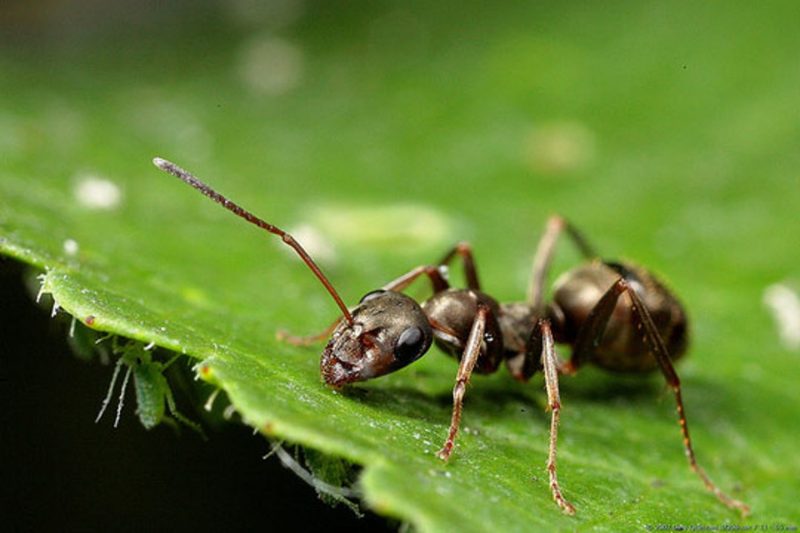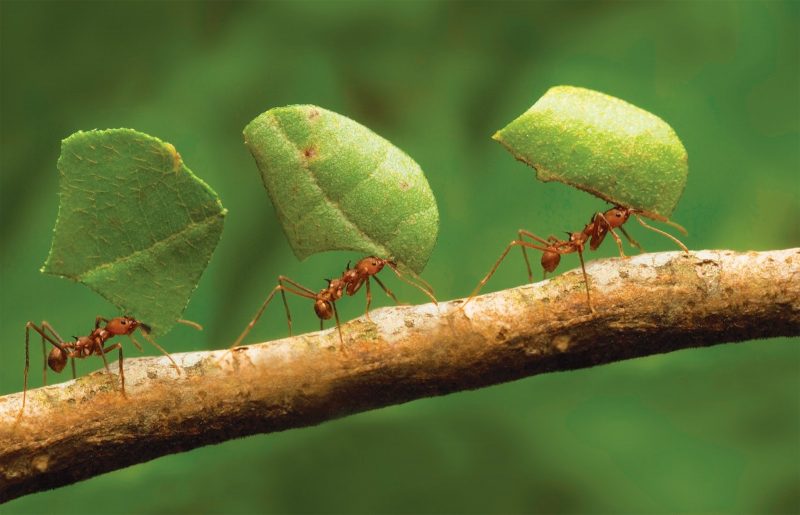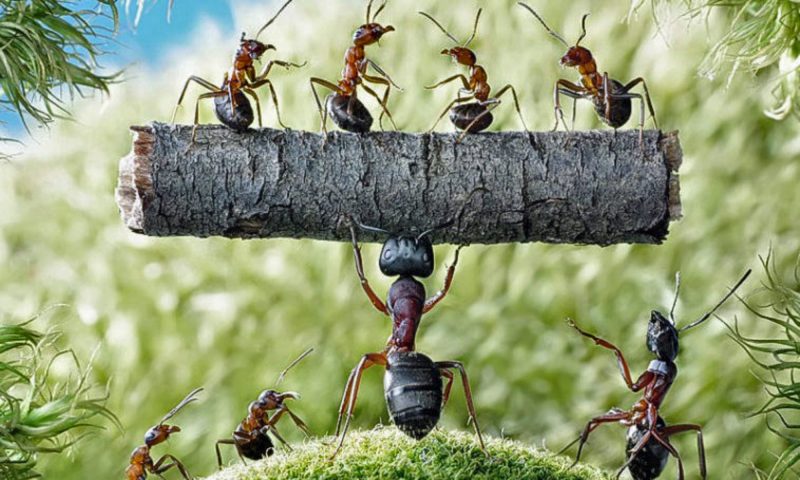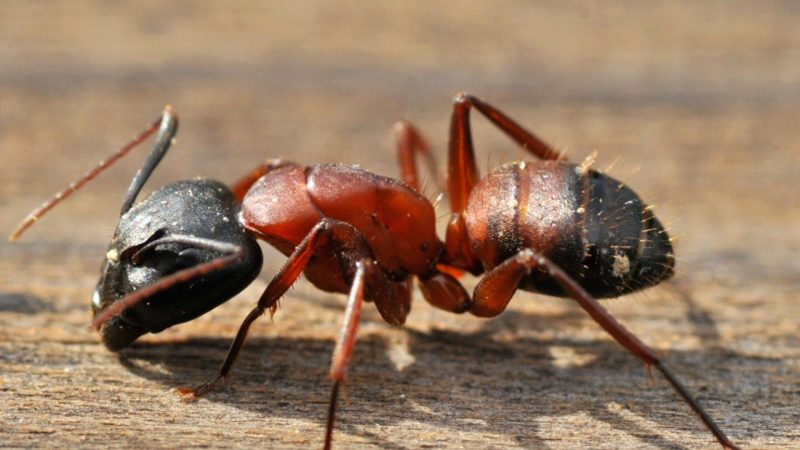Six-legged workers hunt caterpillars, beetle larvae, breed aphids, build reliable dome nests and underground passages. Uninvited neighbors worry the owners of the plot, which is why many are interested in how to get rid of ants in the garden, on the lawn and in the garden. Hardworking insects often switch to eating berries and fruits, climb into homes.
Material Content:
The reasons for the appearance of ants in the garden
Species belonging to the family Ants (Formicidae), are social insects, create families of millions of individuals. Flightless workers maintain cleanliness in the nest, look after larvae and females.

Ants destroy caterpillars, butterflies, spiders, can eat corpses of insects to obtain protein. The "menu" of a large family is complemented by sweet aphids, honey, juice of berries and fruits, seeds. Proboscis pests breed in large numbers in gardens and kitchen gardens, in the fields. Ants rush to these places and find a rich source of carbohydrates.
Home gardens attract six-legged builders with ample food and soft cultivated soil.
Suitable conditions for the construction of the nest, wide opportunities for food production are not the only reasons for the appearance of garden black and yellow earthen ants in vegetable gardens and gardens. This is a forced relocation due to the destruction of the natural habitat during plowing and construction.
What harm do insects do?
Aphids and scale insects suck juices from young shoots, buds, leaves, which cause great harm to agriculture and homestead farming, floriculture. Ants treat some representatives of proboscis insects as their pets: graze, protect from enemies, transfer to fresh shoots, often leave to winter in their nests. Symbiosis with aphids helps ants survive, but reinforces the hostility of the land owners.

Domes can last for decades. Over the years, working individuals build their nests up, dig tunnels-passages inland and in breadth. Ant heaps look harmoniously in the forest and in the meadow, but become a big obstacle in the garden and in the garden. The inconvenience of small builders to houses is even more inconvenient for people.
Winged males and females of black garden ants appear on the terraces, climb into homes, gazebos and any other corners. Insects are attracted by the smells of juicy fruits and other foods. Pharaonic ants living in houses spoil food, annoy people with their other habits.
Choosing an Ant Fight
Sparing and more radical methods of getting rid of insects in the garden are used.

- Black garden ants and related species are repelled by insecticidal plants. Destroy the nest and its inhabitants with hot water.
- Indoor plants mainly use insecticidal plants, baits. Crayon "Mashenka" helps to remove ants in houses. Adhesive tapes are hung up during the breeding season to destroy the winged females and males.
How to get rid of garden ants in the garden forever
Long tunnels and tunnels underground are almost impossible to remove. It is easier to destroy the anthill, then its inhabitants will leave in search of a new habitat. Various physical methods of extermination are used, as well as insecticides containing diazinon.
Folk remedies for getting rid of insects
Substances toxic to insects in the composition of insecticides can be dangerous for the owners of the site and beneficial fauna. Poisons pollute the environment, penetrate the soil, water and plants. Folk remedies in most cases are safer for nature and people, compared with pesticides.

Ants and many other insects have an excellent sense of smell. The most natural way to get rid of six-legged creatures is to plant insecticidal plants near the nest. Strong aromas prevent insects from looking for food and their way home.
Folk remedies for exterminating ants and methods of repelling:
- Laying around the nest of fresh and dried insecticidal plants — tansy, lavender, wormwood, Dalmatian chamomile (feverfew).
- Sprinkle insect dome and paths with lemon peel, cinnamon powder.
- Pouring into the anthill a mixture of equal parts of vegetable oil, inexpensive shampoo and table vinegar.
- Sprinkling nests and tracks with vinegar essence.
- Folding poison baits.
Dangerous for ants substances - boric acid, baking soda, yeast. The bait is prepared from 1 cup of honey, the same volume of water, 30 g of sodium bicarbonate (drinking soda), 1 tsp. table or apple cider vinegar. After mixing the ingredients, a gruel is obtained, which should be applied to the trails and to the places where the ants gather. The sweet taste attracts insects, they eat the bait.
Another popular way is to use borax instead of sodium bicarbonate. The bait should be replaced weekly until complete removal of the ants. A variant of this recipe is a mixture of sugar, honey, borax and water in a ratio of 4: 1: 0.5: 4.5.
Ants do not tolerate alkaline substances. You can mix chalk, lime or soda with powdered sugar. The bait should be poured on an ant trail. Workers die mostly from chemical burns with soda or brown.
Chemical methods of control
Pesticides are powerful drugs, their use is justified in case of failure of other methods.Against uninvited six-legged neighbors, diazinon is used - a chemical remedy for ants in the garden. Intestinal and contact insecticide causes insect paralysis. It is necessary that the organophosphorus compound penetrates through the integument of the body of ants, into the digestive tract.

List of granular pesticides containing diazinon for farms:
- Terradox.
- The Ant.
- Barguzin.
- Thunder 2.
- "Initiative".
Pesticides from the list are used in gardens, gardens, greenhouses and greenhouses. To combat house and black garden ants in the premises, it is better to use concentrated insecticidal gels “FAS” and “Trap-storm”.
It is recommended that the topsoil be removed before being treated with granulated anthill pesticides. Then it should be evenly distributed on the surface of 1 - 3 g of the drug (from 1/10 to 1/3 of a bag of 10 g). The remaining granules are scattered in places of movement and accumulation of insects. Top out the soil with a thin layer.
They introduce an insecticide in places where ants gather on the beds after sowing seeds, planting seedlings, and later during the growing season of plants.
The diazinon emulsion contains preparations:
- "Ant-eater".
- Muratsid.
The liquid form of an enteric contact insecticide acts exactly like granules. Ampoules of 1 ml are enough to handle several anthills.
How to deal with ants using the Anteater solution:
- Dig up the soil around the anthill to lay eggs and chambers with larvae.
- The emulsion is diluted in water in accordance with the instructions.
- An anthill and soil around the nest are watered with a pesticide solution.
- Sprinkle with earth on top.
The advantage of diazinon is the ability to destroy adult ants and larvae. After processing the nests, workers are not able to get food, rebuild the nest, and take care of females and eggs. Diazinon does not harm microflora and earthworms in the soil, since it does not accumulate (collapses). The granular form of release is more convenient in that you do not need to dilute the drug with water. The emulsion penetrates easier through the integument of the body of the insect.
Garden ants will disappear from the site a few days after treatment - permanently or temporarily. Six-legged workers may return after the end of the pesticide after 3 weeks or after 2 to 3 months.
Mechanical methods
You can use the most gentle method of struggle - move the anthill to the forest or to the park. Resettlement is carried out using a container or a large flower pot filled with straw and loose soil. The container is placed on an old ant heap. After some time, the insects move to a new home. After that, you can use a shovel to lift the pot, place it in a plastic bag and transfer it to another place at a distance of at least 30 m from the old nest.

Sticky hunting belts help save ants from carrying aphids. Insects stick to Velcro, can not be released and die. Glue for such traps is prepared from non-toxic substances that do not harm plants and people. The belt is placed at a height of 60 - 80 cm from the soil surface; it is not removed from March to October. Sets are designed for 5 - 6 trees. Belt length 3.5 m, width 14 cm.
Only by destroying the nest and a large number of working individuals do we get rid of ants forever.
Methods of physical extermination:
- Pouring boiling water or a hot broth of tomato tops into the anthill.
- Use of kerosene instead of boiling water.
- Burning the inside of the nest with coals of fire from a fire.
The anthill is poured several times with boiling water or hot broth until the death of the entire colony.
Prevention of the appearance of ants in the garden
Insects are champions of the animal world in adaptations to changing conditions. In addition, getting rid of ants in the garden, in the garden, in the house makes it difficult for many families. Six-legged neighbors can live in the same nest for decades.

In the breeding season, winged females and males appear.They come to the surface for mating once or several times a year. Fertilized females build new nests near the mother dome or set off in search of another place. Initially, there can only be one anthill in the garden or in the garden, but after a year new families appear.
Excessive spread of insects on the site can be prevented by timely harvesting of ripened fruits, collecting carrion. It is necessary to destroy the food base for the larvae of ants - aphids and scale insects, to prevent infection of plants with pests and diseases.












